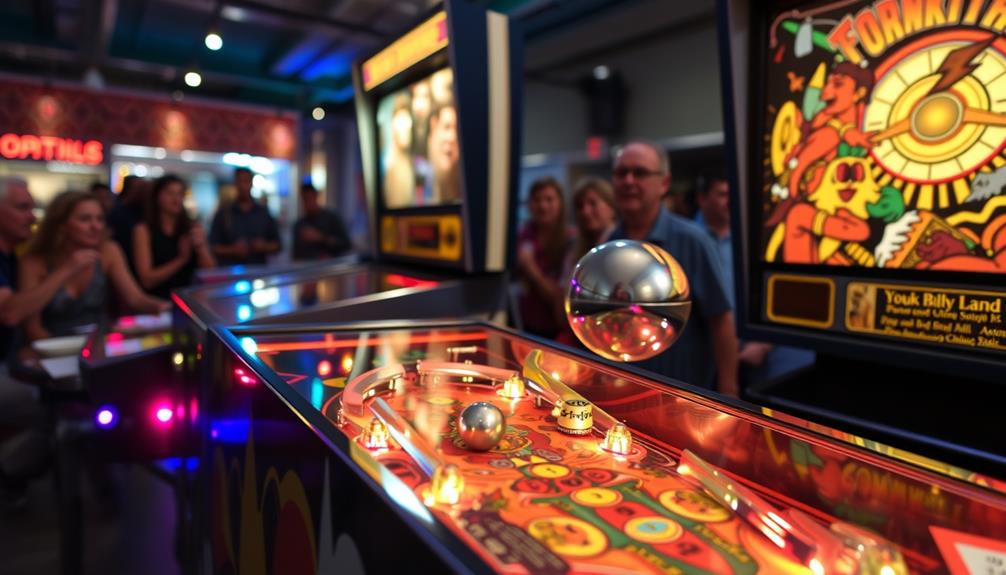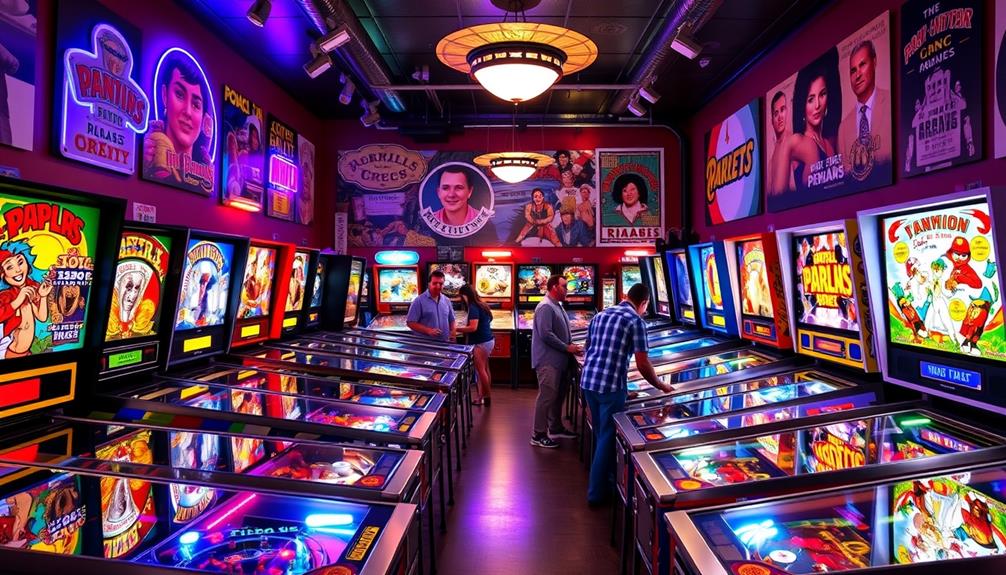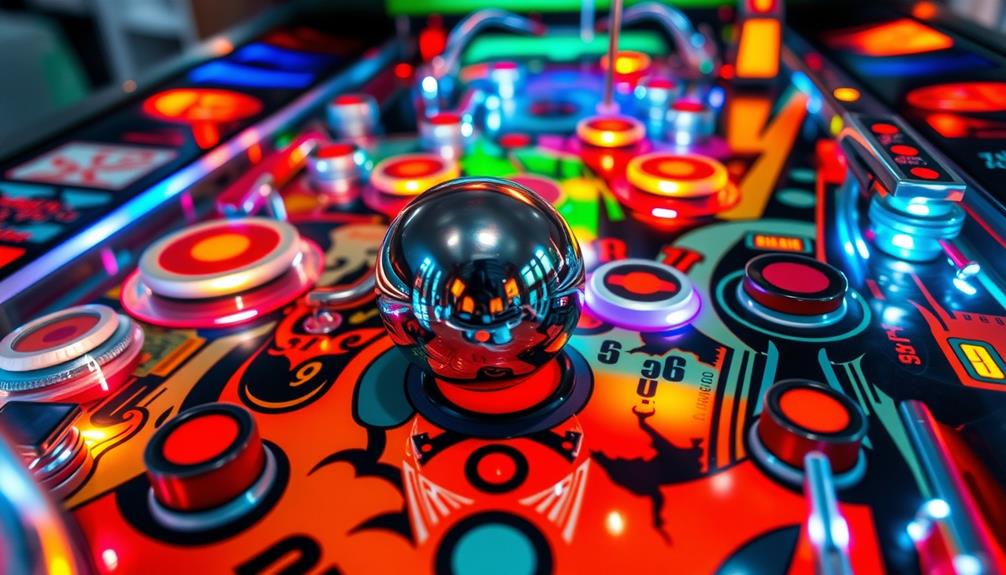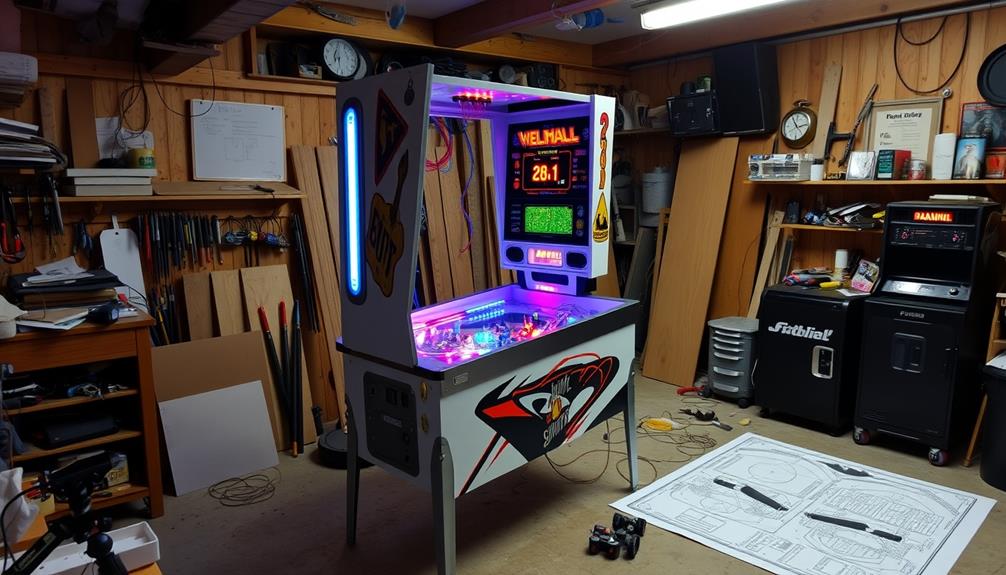A pinball machine is an interactive form of entertainment that challenges players to earn points by manipulating a steel ball. It features a variety of targets, ramps, and bumpers that enhance the gameplay experience. By controlling flippers to guide the ball’s trajectory, players aim to keep it in play and achieve a high score. These machines combine skill and luck, making each game unique. Over time, they have evolved from simple mechanical games to complex devices with advanced electronics. If you are interested in its fascinating history and recent developments, there is plenty more to explore about this captivating game.
Key Takeaways
- A pinball machine is an amusement device where players score points using a steel ball, navigating obstacles and targets on an inclined playfield.
- It features flippers, which are controlled levers that allow players to direct the ball and enhance gameplay strategy.
- Pinball machines include scoring mechanisms that track points and provide feedback during play.
- Modern machines utilize microprocessors and LCD screens for advanced gameplay, sound effects, and visual enhancements.
- Historically, pinball has evolved from mechanical games in the 18th century to complex, interactive experiences seen in contemporary arcades.
Definition of Pinball Machine
A pinball machine is an exciting amusement device that challenges players to score points by launching a steel ball down an inclined playfield. This playfield is designed with various targets and features, like bumpers and ramps, that you interact with to maximize your score. The sound effects and flashing lights add to the thrill of playing, making pinball machines a popular choice in arcades and entertainment venues. Pinball machine dimensions can vary, but they typically measure around 30 inches wide, 56 inches long, and 76 inches high. These measurements can give players an idea of the space needed to accommodate this classic game.
The game often attracts players with its unique blend of skill and chance, much like how astrology claims to influence personality traits and attractiveness. You use a spring-loaded plunger to propel the ball, and your aim is to hit specific targets that will reward you with points.
The game combines elements of chance and skill, as you need to anticipate the ball's movement and react quickly. Pinball machines are typically housed in a sturdy wooden cabinet, tilted at about 6.5 degrees to facilitate smooth ball movement.
As you play, your score gets tracked on a display, providing instant feedback on your performance.
Modern pinball machines have embraced technology, incorporating microprocessors and LCD screens to enhance the gameplay experience. These advancements make the playfield more interactive, adding layers of complexity and excitement to scoring points.
Whether you're a beginner or a seasoned player, the thrill of pinball lies in mastering its mechanics and achieving high scores.
Historical Origins of Pinball
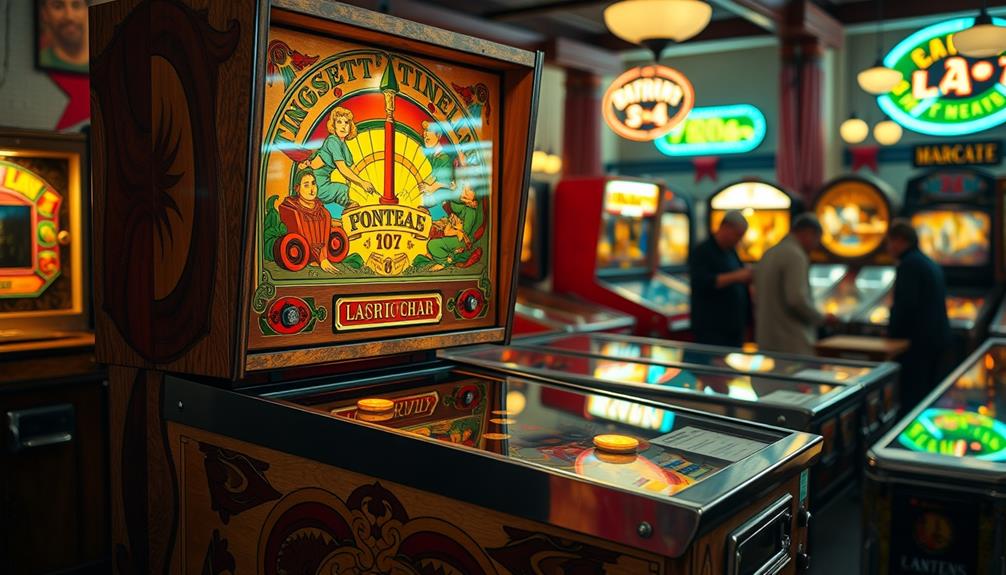
When you think about the historical origins of pinball, it all starts with early mechanical games like Bagatelle, where players aimed to score by hitting balls into pockets.
These early games laid the groundwork for the development of more complex gaming experiences. As coin-operated machines began to evolve in the 1930s, designs became more sophisticated and engaging, reflecting the changing tastes of the public and the growing interest in common financial terms and jargon.
The introduction of player-controlled flippers in 1947 marked a major shift, transforming pinball into a game of skill that we recognize today.
Early Mechanical Games
How did early mechanical games lay the groundwork for what we now know as pinball? It all started with Bagatelle, a popular parlor game from the late 18th century where players used a cue stick to shoot balls into scoring pockets. This laid the foundation for the mechanics we see in pinball today, as it encouraged players to engage in nurturing an imaginative mindset through strategy and skill.
In 1871, Montague Redgrave patented an improved version of Bagatelle, introducing a coiled spring and plunger mechanism that added a new level of excitement and control, shaping the future of mechanical games.
By the 1930s, the term "pinball" was officially coined and marked a significant evolution in gaming. The introduction of Baffle Ball, the first modern coin-operated pinball machine, allowed players to launch steel balls and aim for various targets. This innovation transformed casual play into a competitive experience.
Additionally, the tilt mechanism introduced by Harry Williams in 1935 guaranteed fair play, penalizing those who tried to cheat by physically manipulating the machine.
These early mechanical games not only influenced the design and gameplay of pinball but also set the stage for its rise as a beloved arcade staple.
Coin-Operated Evolution
From the early days of mechanical games to the vibrant arcades of the mid-20th century, the evolution of coin-operated pinball machines reflects a fascinating journey of innovation and entertainment.
The first pinball machine, known as the "whiffle board," emerged in the 1930s, marking a significant shift in accessibility and popularity. This era saw the term "pinball" officially coined in 1936, solidifying the game's identity.
The rise of coin-operated games paralleled the growth of various entertainment options, including Gold IRAs for retirement planning, which also gained popularity around that time.
In 1931, Gottlieb's "Baffle Ball" became the first major hit in the coin-operated era, selling for $17.50 and allowing players to enjoy multiple balls for just a penny. This sparked a surge in pinball manufacturing, as more companies recognized the potential for profit and fun.
The introduction of electrification in 1933 with Pacific Amusements' "Contact" revolutionized the gameplay experience, adding sound and lighting effects that captivated players.
Post-WWII, pinball's popularity skyrocketed, with machines becoming staples in arcades and entertainment venues across the United States.
The rise of electromechanical games during this period further enhanced player engagement, cementing pinball's status as a beloved pastime that continues to evolve today.
Flipper Innovation
Pinball took a thrilling turn in 1947 with the introduction of player-controlled flippers in Gottlieb's Humpty Dumpty. This innovation transformed the game from a game of chance to one of skill and strategy, similar to how uplifting music can evoke emotions and enhance experiences.
You could now actively engage with the ball, making gameplay much more exciting. Here are three key developments in flipper innovation:
- First Flippers: Humpty Dumpty was the first to feature flippers at the bottom, allowing players to direct the ball and enhance their scoring potential.
- Triple Action (1950): Designed by Steve Kordek, this was the first game with two outward-facing flippers, expanding the dynamics of gameplay even further.
- Just 21 (1950): Gottlieb's release included inward-facing flippers, optimizing ball control and player interaction.
The popularity of these flippers led to the decline of older non-flipper machines, fundamentally changing the pinball landscape.
As you play, you'll appreciate how these innovations not only increased engagement but also set the stage for the intricate strategies involved in modern pinball. Flippers turned a simple pastime into a competitive challenge, inviting you to master your skills.
Key Components of Pinball Machines
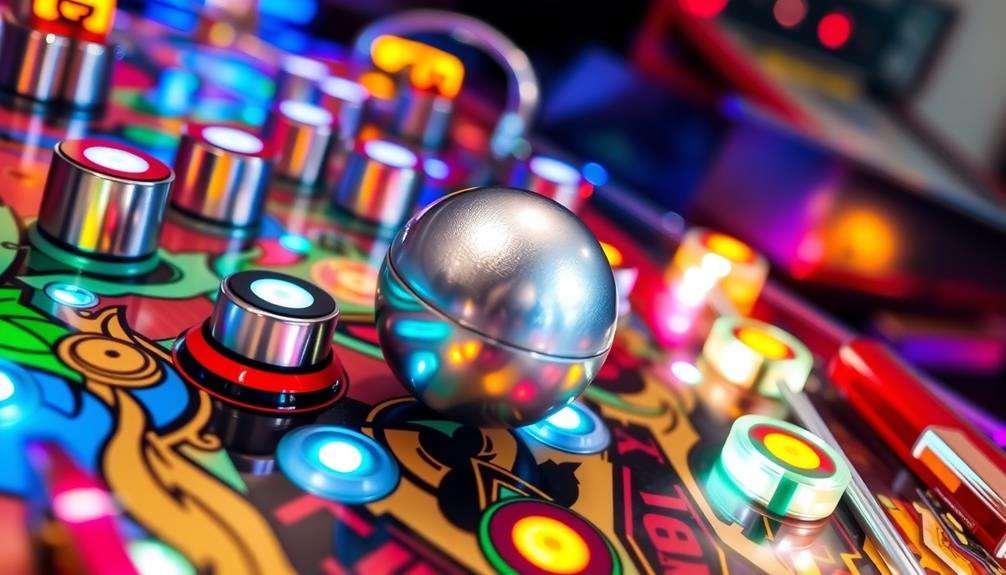
Five key components make up a pinball machine, each playing an essential role in the game's functionality and player experience.
First, the cabinet provides a sturdy frame that houses the playfield and various mechanical components. It serves as the foundation of the machine, ensuring everything operates smoothly. The cabinet can also be designed with eye-catching art and themes, enhancing the visual appeal, much like family photoshoot fails that often yield unexpected moments.
Next, the playfield is the inclined area where the action unfolds. It's filled with obstacles like bumpers, ramps, and targets that interact with the ball, creating a dynamic environment for players. Your primary goal on the playfield is to keep the ball in play and score points.
Another vital component is the flippers. These levers, controlled by you, allow you to hit the ball, markedly influencing your strategy and gameplay. They give you the power to keep the ball from draining and to aim for specific targets on the playfield.
Gameplay Mechanics and Objectives
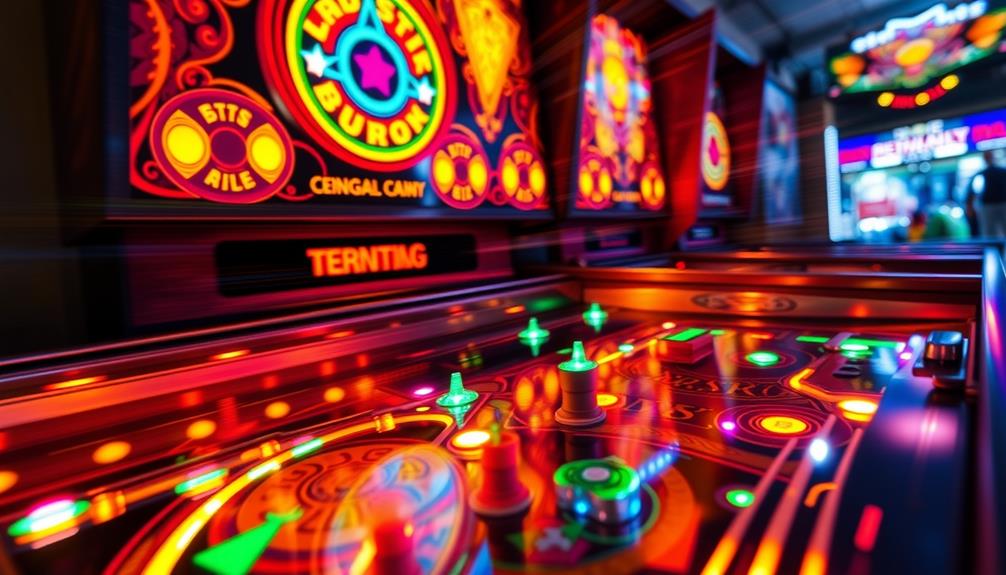
Once you've familiarized yourself with the key components of a pinball machine, it's time to explore how gameplay works and what objectives you should aim for.
In pinball games, you start by inserting a coin, releasing the spring plunger, and launching the ball with the ball shooter. Your goal is to rack up points by interacting with various components on the playfield, similar to how unique party options enhance celebrations in other entertainment settings.
Here are three key objectives to focus on during gameplay:
- Score Points: Aim for bumpers, gates, and targets to accumulate points. Each interaction contributes to your total score.
- Complete Missions: Many pinball machines feature unique challenges based on their theme. Completing these missions can reveal special rewards or additional scoring opportunities.
- Avoid the Tilt Mechanism: Introduced in 1935, this feature prevents cheating by detecting excessive movement. If you trigger it, you'll be penalized, so keep your movements controlled.
As you play, aim for high scores and compete for your initials on the leaderboard, adding a fun competitive edge to your experience.
Embrace the objectives, and you'll enhance your pinball skills in no time!
Technological Advancements in Pinball
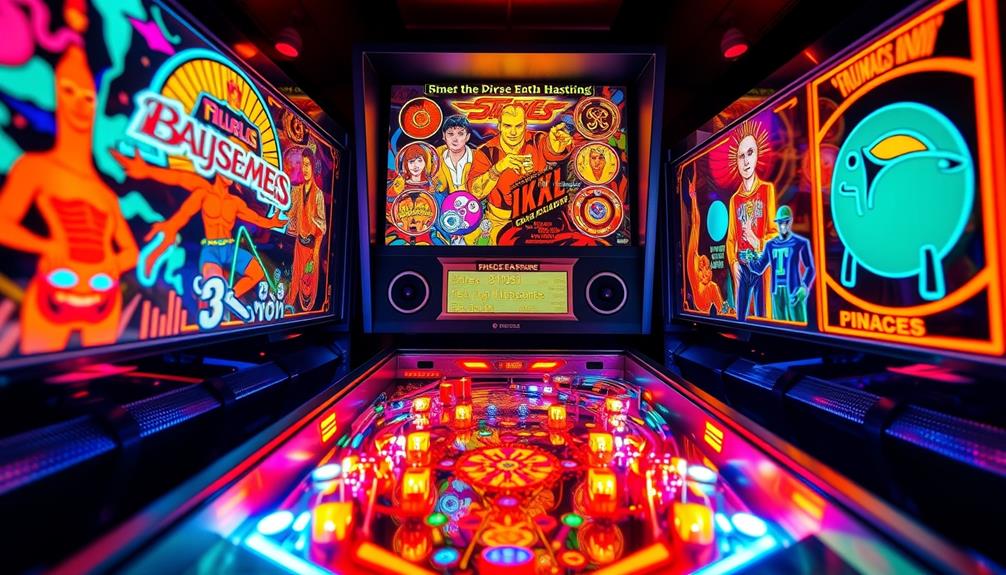
You might be surprised to learn how far pinball technology has come since the early days. The microprocessor revolution transformed gameplay, allowing for more complex rules and features, while display technology has evolved from simple scoreboards to vibrant, interactive screens.
Innovative coffee gear and accessories can elevate experiences much like these advancements in pinball. These advancements not only enhance your experience but also keep pinball machines fresh and exciting.
Microprocessor Revolution
In the early 1970s, the pinball industry underwent a significant transformation with the advent of microprocessor technology. This revolution began with Bally's prototype machine, Flicker, in 1974, making it the first to use a microprocessor for gameplay control.
The introduction of microprocessors not only enhanced gameplay but also enriched the overall player experience, encouraging deeper self-reflection in players as they engaged with the game. This shift aligns with the insights from modern artists, who stress the importance of imagination in creativity.
Here are three major impacts of the microprocessor revolution:
- Complex Game Mechanics: You'll find that the integration of microprocessors allowed for intricate scoring systems, making gameplay more engaging.
- Solid-State Electronics: The shift to solid-state technology, highlighted by Williams' Hot Tip in 1977, replaced clunky electromechanical relays, streamlining production and boosting reliability.
- Interactive Elements: With the microprocessor, modern machines feature advanced graphics and interactive displays, appealing to a broader audience and transforming pinball into a dynamic experience.
Bally's Eight Ball, released in 1977, became a bestseller, showcasing these new capabilities.
The microprocessor advancement laid the groundwork for the evolving narratives and immersive gameplay you see in today's pinball machines.
Display Technology Evolution
The evolution of display technology in pinball machines reflects a remarkable journey of innovation and creativity. From their inception, these machines have transformed considerably, enhancing both gameplay and player engagement.
| Year | Display Technology Description |
|---|---|
| 1933 | First electrically powered machines introduced sound effects via bells and buzzers. |
| 1934 | Colored glass and lights began to enhance visual appeal. |
| 1975 | Micro's Spirit of 76 launched the first solid-state electronic pinball machine. |
| 2010s+ | Modern machines embraced LCD screens for high-resolution visuals and immersive gameplay. |
As you explore the world of pinball, you'll notice how advanced display technology, like that in Stern Pinball's "Jurassic Park," incorporates animatronics and interactive features. These innovations not only elevate the aesthetics but also create a dynamic environment that keeps you coming back for more. The shift from mechanical components to integrated circuits has paved the way for a richer gaming experience, allowing you to enjoy vibrant animations and enthralling soundscapes. So, next time you play, take a moment to appreciate the technological advancements that have shaped your pinball experience!
Market Trends and Industry Changes
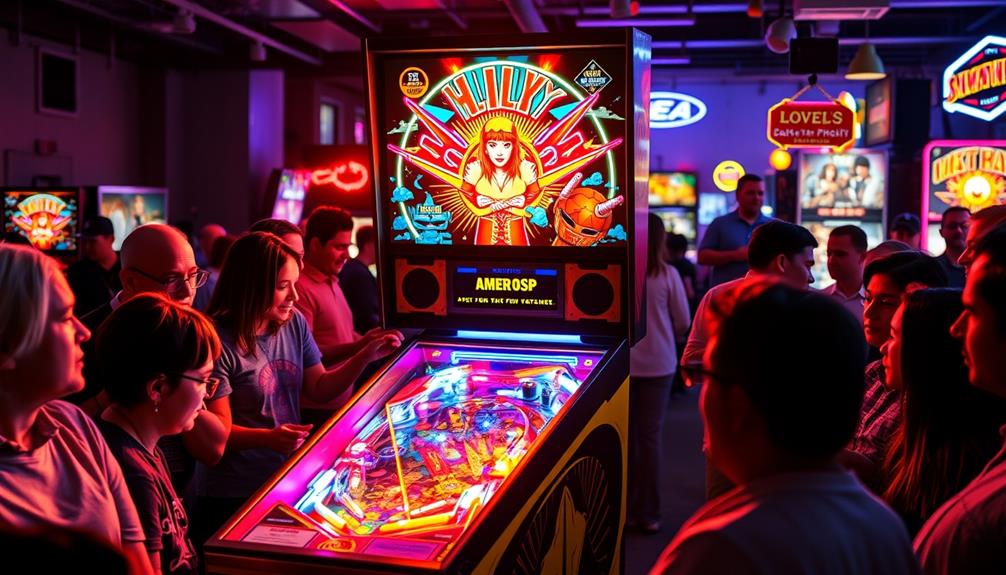
Pinball machines have experienced a rollercoaster of market trends and industry changes over the decades. From the early 1990s boom, driven by iconic titles like "The Addams Family," to the decline in the late 1990s, the industry has seen its share of ups and downs.
As technology continues to evolve, the demand for skilled roles in related sectors like AI software engineering may also impact the gaming industry.
Here are three key trends shaping the market:
- Impact of Video Games: The Video Game Crash of 1983 forced pinball manufacturers to pivot, leading to the rise of companies like Capcom Pinball and Data East Pinball, which revitalized the industry.
- Technological Innovations: The introduction of microprocessor technology in the 1970s, exemplified by Bally's "Flicker," transformed pinball design, making machines more engaging and complex.
- Resurgence of Interest: Since the 2010s, nostalgia for retro gaming and home entertainment has spurred demand for both vintage and new pinball machines, resulting in significant price increases.
Navigating these market trends, pinball manufacturers have adapted to changing consumer preferences, making the industry more resilient and vibrant in today's entertainment landscape.
Cultural Impact of Pinball
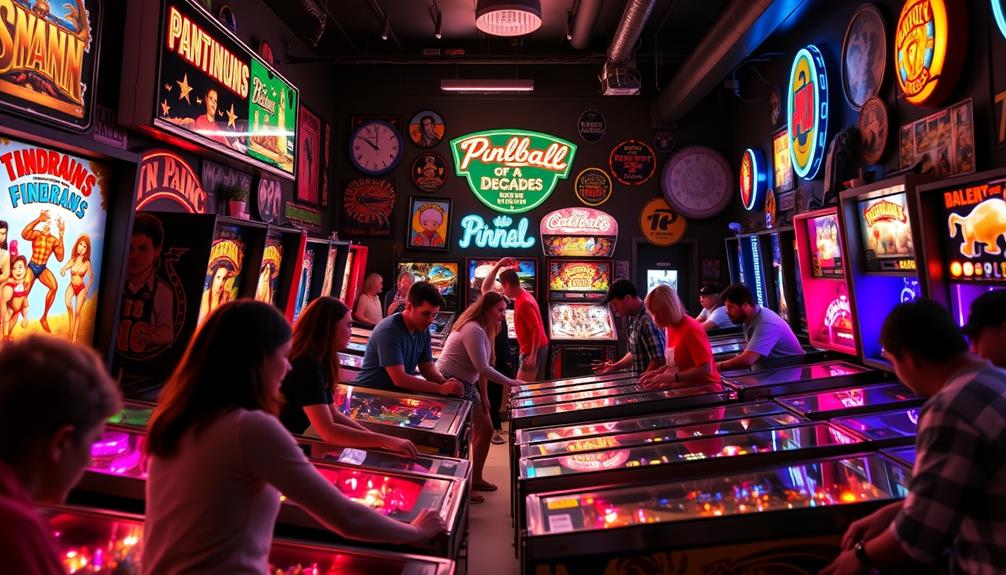
Pinball's cultural impact can't be overstated, as it shapes competitive tournaments that attract players worldwide.
You'll find its iconic presence in movies and TV shows, solidifying its status in pop culture.
Plus, the resurgence of retro gaming has made vintage machines highly sought after, blending nostalgia with art appreciation.
Competitive Tournaments Influence
In recent years, competitive pinball tournaments have transformed the landscape of this classic game, turning it into a recognized sport with a passionate following. Organizations like the International Flipper Pinball Association (IFPA) have played a pivotal role, hosting events that attract thousands of players worldwide.
Here are three key influences of competitive tournaments:
- World Championship Prestige: The IFPA's annual World Championship showcases top players, elevating pinball's status and competitiveness.
- Diverse Game Exposure: Tournaments feature a variety of machines, allowing you to demonstrate skills across different game designs, fostering a diverse competitive environment.
- Increased Visibility: Live streaming of these events engages audiences, drawing in newcomers who may not have understood pinball's intricacies before.
The rise of competitive pinball tournaments has created a vibrant community of enthusiasts.
Players share strategies, techniques, and experiences, enhancing the cultural significance of pinball in modern gaming.
This dynamic culture not only celebrates the art of play but also guarantees that pinball continues to thrive as both a hobby and a competitive pursuit.
Iconic Pop Culture Presence
Nostalgia and entertainment intertwine in the iconic presence of pinball within pop culture, marking its significance in both film and television. You've likely seen pinball machines featured in classics like "The Wizard" (1989) and "Happy Days," reinforcing their cultural relevance.
These machines aren't just games; they embody a shared experience that resonates with many. Iconic pinball machines, such as "The Addams Family" and "Medieval Madness," have achieved cult status, selling over 20,000 units and becoming highly sought-after collectibles. Their design and gameplay have captured the imagination of enthusiasts around the world.
The International Flipper Pinball Association (IFPA) has also contributed to this phenomenon by organizing tournaments that showcase these beloved machines, gathering competitive players and fans alike.
In addition, pinball's influence extends beyond the arcade. You'll find it celebrated in popular music, merchandise, and art, highlighting its role as a symbol of classic amusement and social interaction.
As you explore the vibrant landscape of pop culture, the imprint of pinball machines remains unmistakable, reminding you of the joy and nostalgia they continue to inspire.
Retro Gaming Revival
The resurgence of pinball in the 2000s reflects a broader trend in retro gaming, where players are rediscovering the charm of vintage machines.
You've likely noticed how pinball machines have gained popularity in homes, leading to a booming market for collectors and restorers. This revival isn't just about nostalgia; it's about a tactile experience that digital games can't replicate.
Here are three key factors driving this retro gaming revival:
- Community Engagement: Pinball tournaments and trade shows have created vibrant spaces for enthusiasts, strengthening connections among players and manufacturers.
- Nostalgic Themes: Many pinball machines feature beloved characters and stories, drawing in both new players and those wanting to relive childhood memories.
- Cultural Significance: You'll find pinball's influence in dedicated arcades and museums, showcasing its lasting impact on gaming history.
As you explore this world, you'll appreciate how pinball machines not only reflect a love for retro gaming but also foster a sense of community among collectors.
This cultural impact guarantees pinball remains an exciting part of gaming's evolution.
Challenges Facing the Pinball Industry
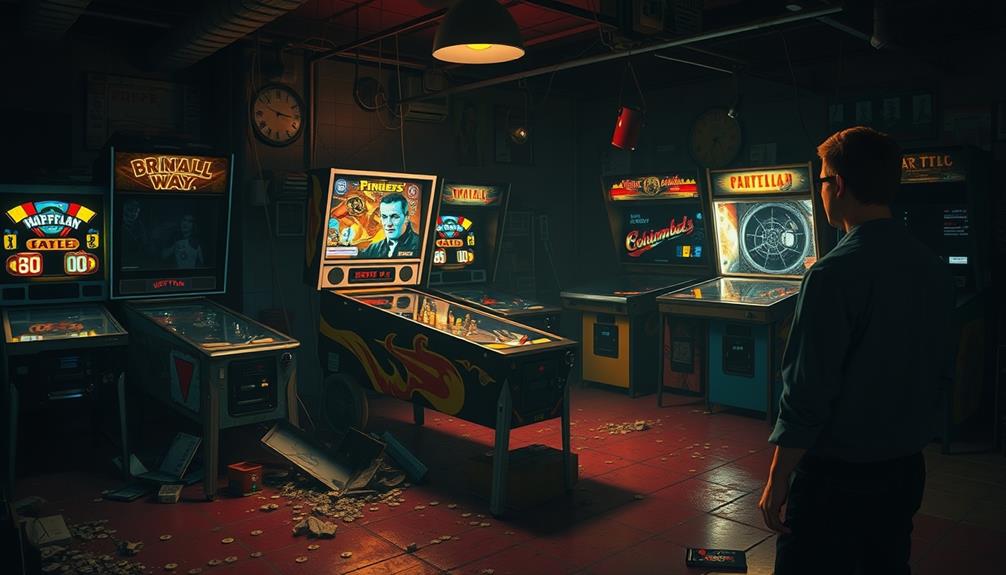
Facing significant challenges, the pinball industry finds itself at a crossroads. You may have noticed the declining sales of pinball machines over the years, with manufacturers like Williams selling fewer than 4,000 units by the late 1990s. This downturn largely stemmed from competition with video games and shifting consumer preferences.
The Video Game Crash of 1983 hit the industry hard, forcing manufacturers to rethink their approach as arcade foot traffic dwindled. Unfortunately, the closure of major companies like Gottlieb and Capcom by 1996 signaled a decline in innovation and consolidation among manufacturers.
Even though there was a brief resurgence in the 2000s, the challenges persist. High production costs are a significant hurdle, making it difficult for companies to maintain profitability while appealing to a broader audience, especially younger gamers.
Moreover, the rise of virtual pinball machines (vpins) and hybrid gaming experiences adds complexity to the landscape. While these innovations present new opportunities, they also challenge traditional manufacturers to adapt or risk becoming obsolete.
If the industry can find a way to navigate these obstacles, it may yet find a path forward.
Future of Pinball Games
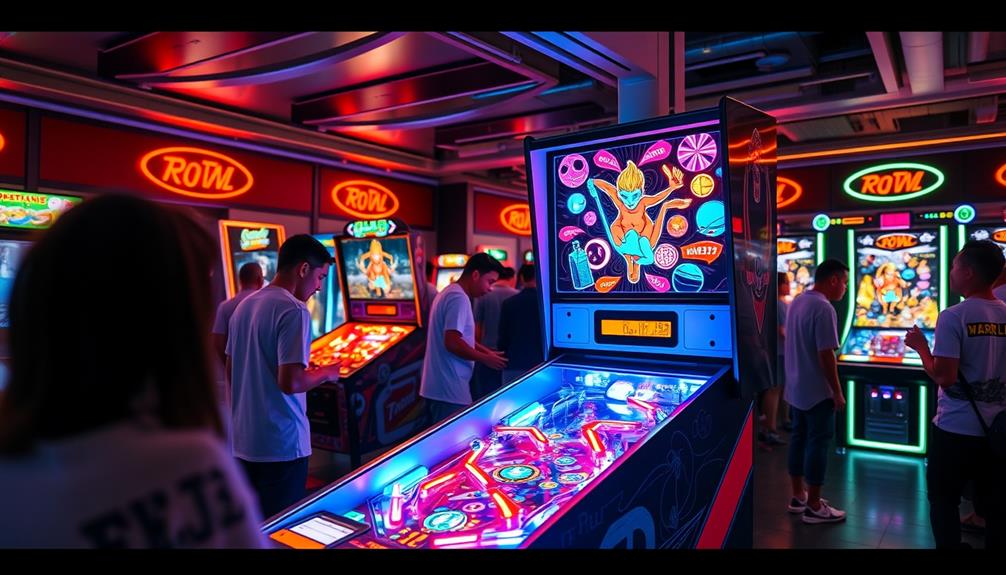
As pinball games evolve with technology, players can expect a vibrant future filled with interactive features and engaging gameplay.
Advanced technology is driving innovations that will redefine the pinball experience. You'll find new pinball machines incorporating elements that enhance immersion, similar to those in popular titles like Stern Pinball's "Jurassic Park."
Here are three exciting trends to look forward to:
- Interactive Gameplay: Expect machines with animatronics and dynamic lighting that respond to your actions, making each playthrough unique.
- Retro Aesthetic with Modern Mechanics: The growing interest in retro gaming means new pinball machines will feature nostalgic designs while integrating contemporary gameplay mechanics.
- Hybrid Experiences: The potential for combining virtual reality with physical pinball could broaden your gaming options and attract a wider audience.
As home enthusiasts continue to invest in personal pinball machines, the market is thriving.
With manufacturers like Jersey Jack Pinball and Spooky Pinball leading the charge, you'll see features like large color displays and online connectivity.
The future of pinball games is bright, merging nostalgia with advanced technology to create unforgettable experiences.
Fun Facts About Pinball
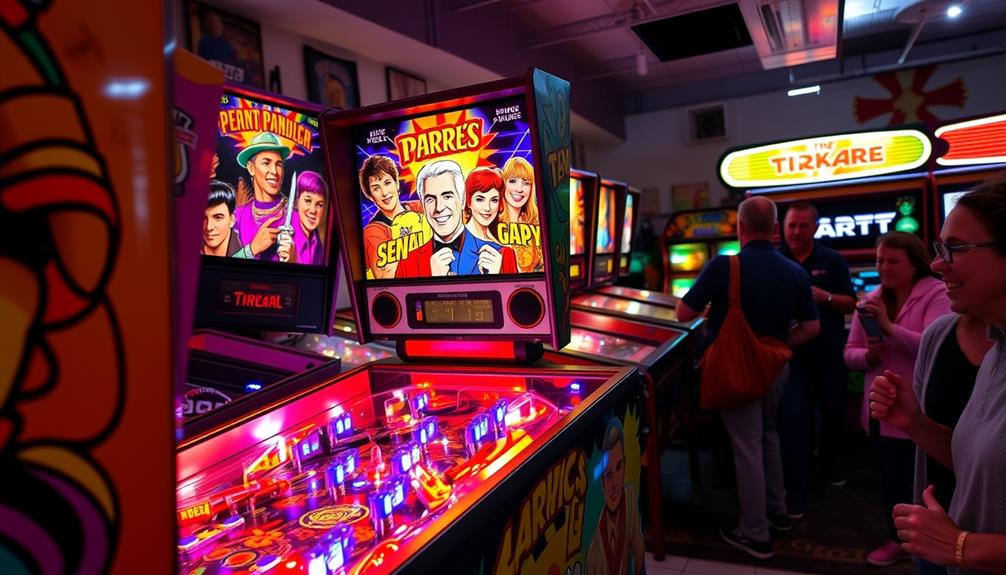
Pinball's rich history and quirky culture are filled with fascinating tidbits that might surprise you. Did you know the first pinball machine, known as "Bagatelle," was created in the 18th century? It laid the groundwork for modern pinball designs that you see in arcades today.
One of the most impressive feats in the history of pinball is the highest score ever recorded on a single machine, which exceeds 1 billion points! This showcases the extreme skill and dedication of top players who aim for as many points as possible.
Contemporary pinball machines have evolved, incorporating digital displays and interactive elements that merge traditional gameplay with advanced technology.
Many collectors regard these machines as a form of art. They appreciate the intricate designs, unique themes, and craftsmanship that go into creating each one.
If you're interested in adding a competitive edge to your gameplay, the International Flipper Pinball Association (IFPA) promotes competitive play and organizes tournaments.
This highlights the global community and enthusiasm surrounding pinball gaming, making it a vibrant part of its history.
Frequently Asked Questions
What Is the Purpose of a Pinball Machine?
The purpose of a pinball machine's to engage you in a fun, competitive experience. You score points by hitting targets, completing missions, and traversing ramps, all while enjoying the social atmosphere it creates.
What Is Pinball and Why Was It Illegal?
At its peak, over 300,000 pinball machines operated in the U.S. by the 1940s. You'd find them banned due to their gambling associations, with cities fearing they encouraged illegal betting and crime.
What Is the Concept of Pinball?
You're engaging in a game where skill and precision matter. You propel a ball, navigate obstacles, and aim for high scores. It's all about timing, strategy, and enjoying that satisfying rush with every successful shot.
Why Are They Called Pinball Machines?
Imagine a dance of metal and wood; they're called pinball machines because of the pins that guide your ball's journey. You aim for those targets, turning luck into skill as you chase your high score.
Conclusion
To sum up, pinball machines are more than just games; they're a blend of art, technology, and nostalgia. Did you know that as of 2020, there were over 40,000 pinball machines in operation worldwide? This vibrant community showcases the enduring appeal of pinball, even in the digital age. As the industry evolves, it continues to captivate players of all ages, ensuring that the thrill of the game rolls on for years to come.
